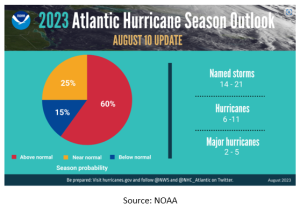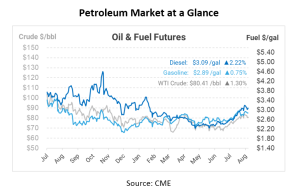
On Alert: NOAA Raises Hurricane Activity Forecast
As the Atlantic hurricane season progresses, experts at the National Oceanic and Atmospheric Administration’s (NOAA) Climate Prediction Center have updated their previous forecast, anticipating more storm activity for this year.
According to the new forecast, the chances of experiencing an above-normal Atlantic hurricane season have increased to 60%, up from the previously predicted 30% in May’s outlook. On the other hand, the chances of near-normal activity have decreased to 25%, down from the earlier 40%. With this adjustment, the Atlantic now faces only a 15% chance of witnessing a below-normal hurricane season.
2023 Hurricane Season Outlook
The current hurricane season embarked on a dynamic start, with five storms already achieving tropical storm status and one hurricane formed. Compared to the average hurricane season – which usually brings 14 named storms, including seven hurricanes and three major hurricanes — the 2023 season is expected to have 14-21 named storms with winds of 39 mph or greater. Of these, 6-11 could potentially escalate into hurricanes with winds surpassing 74 mph, while 2-5 could intensify further into major hurricanes boasting winds of 111 mph or more. You can learn more about the Saffir-Simpson Hurricane Wind Scale here.

According to Matthew Rosencrans, NOAA’s lead forecaster at the Climate Prediction Center, “the main factors to influence this hurricane season are the ongoing El Nino and the record-warm Atlantic sea surface temperatures. Considering those factors, the updated 2023 outlook calls for more activity, so we ask everyone to prepare now for the continuing season.”
While El Nino conditions are currently in play, there is a high probability — exceeding 95% — that it will persist throughout the Northern Hemisphere winter. Typically, it brings atmospheric conditions that help reduce tropical activity during the Atlantic hurricane season. However, these usual conditions have been slow to manifest, and climate scientists are now speculating that the associated impacts that tend to limit tropical cyclone activity may not be in place for much of the remaining hurricane season.
Therefore, it becomes crucial for residents of hurricane-prone regions to have an emergency response plan in place and remain well-informed using official sources. Due to the unpredictable character of hurricanes, the ability to forecast their landfall becomes possible only about a week prior to the storm’s approach.
Being prepared is the key to effectively safeguarding operations, protecting employees, and maintaining continuity, even in the face of potential fuel supply disruptions caused by hurricanes. You can learn more about the storm season and how to get prepared here!
Mansfield Energy, North America’s leading fuel distributor, brings a wealth of expertise to the table in creating a robust emergency response program tailored to your company’s needs. Mansfield’s program offers a multi-tiered approach, prioritizing essential services and collaborating closely with partners to ensure seamless fuel distribution during emergencies. Contact us today!

This article is part of Daily Market News & Insights
MARKET CONDITION REPORT - DISCLAIMER
The information contained herein is derived from sources believed to be reliable; however, this information is not guaranteed as to its accuracy or completeness. Furthermore, no responsibility is assumed for use of this material and no express or implied warranties or guarantees are made. This material and any view or comment expressed herein are provided for informational purposes only and should not be construed in any way as an inducement or recommendation to buy or sell products, commodity futures or options contracts.





